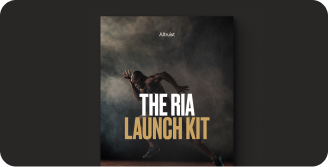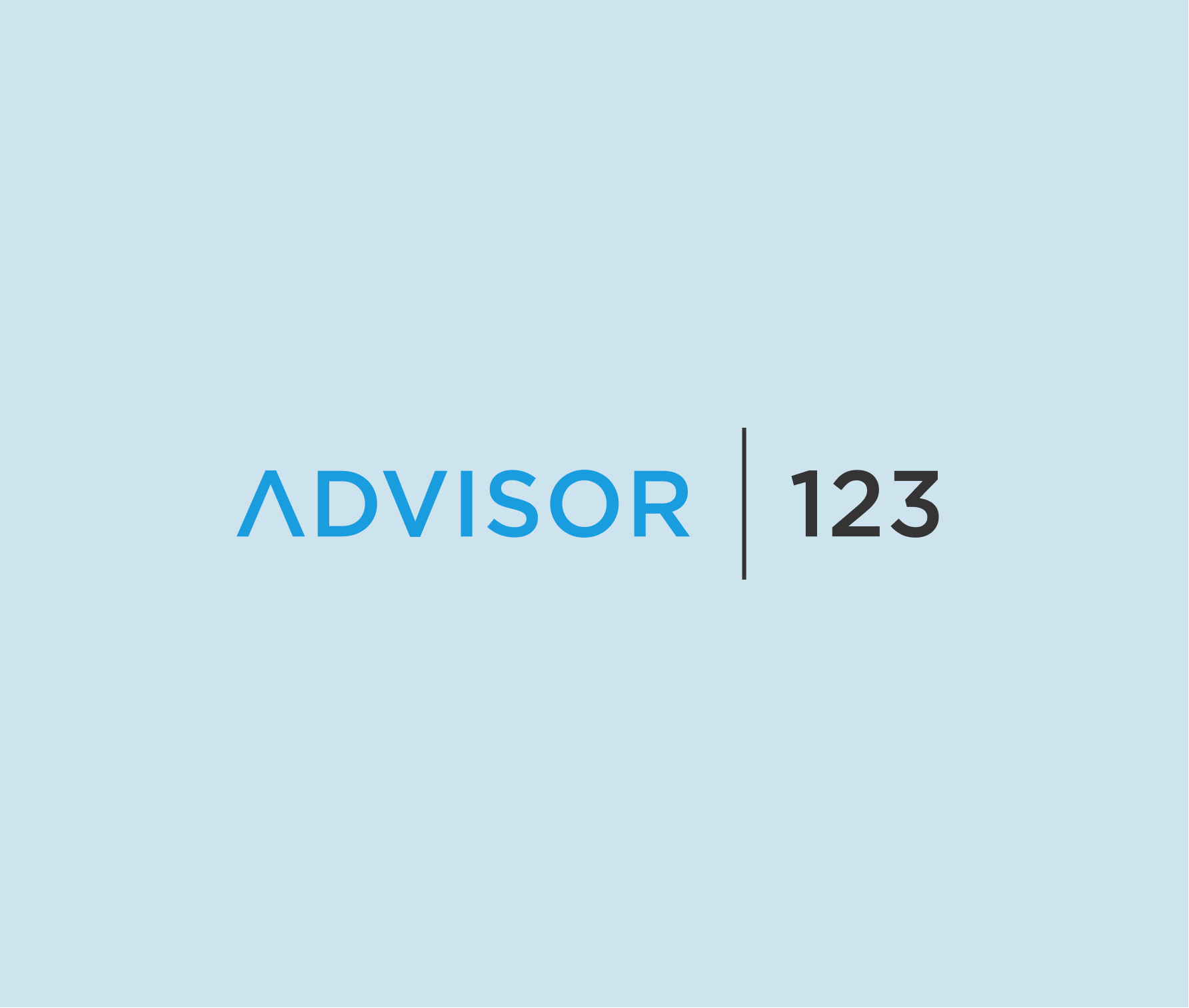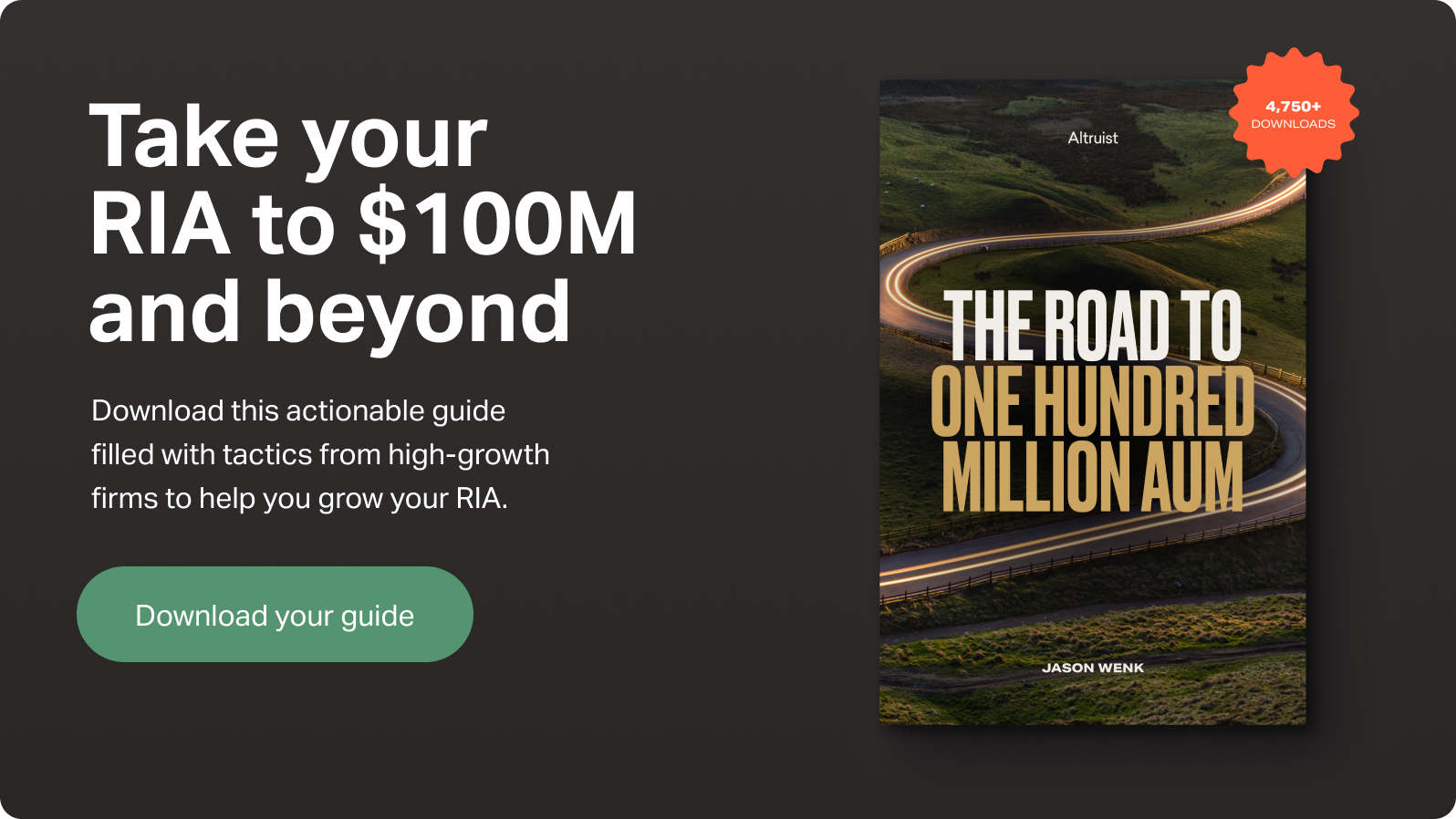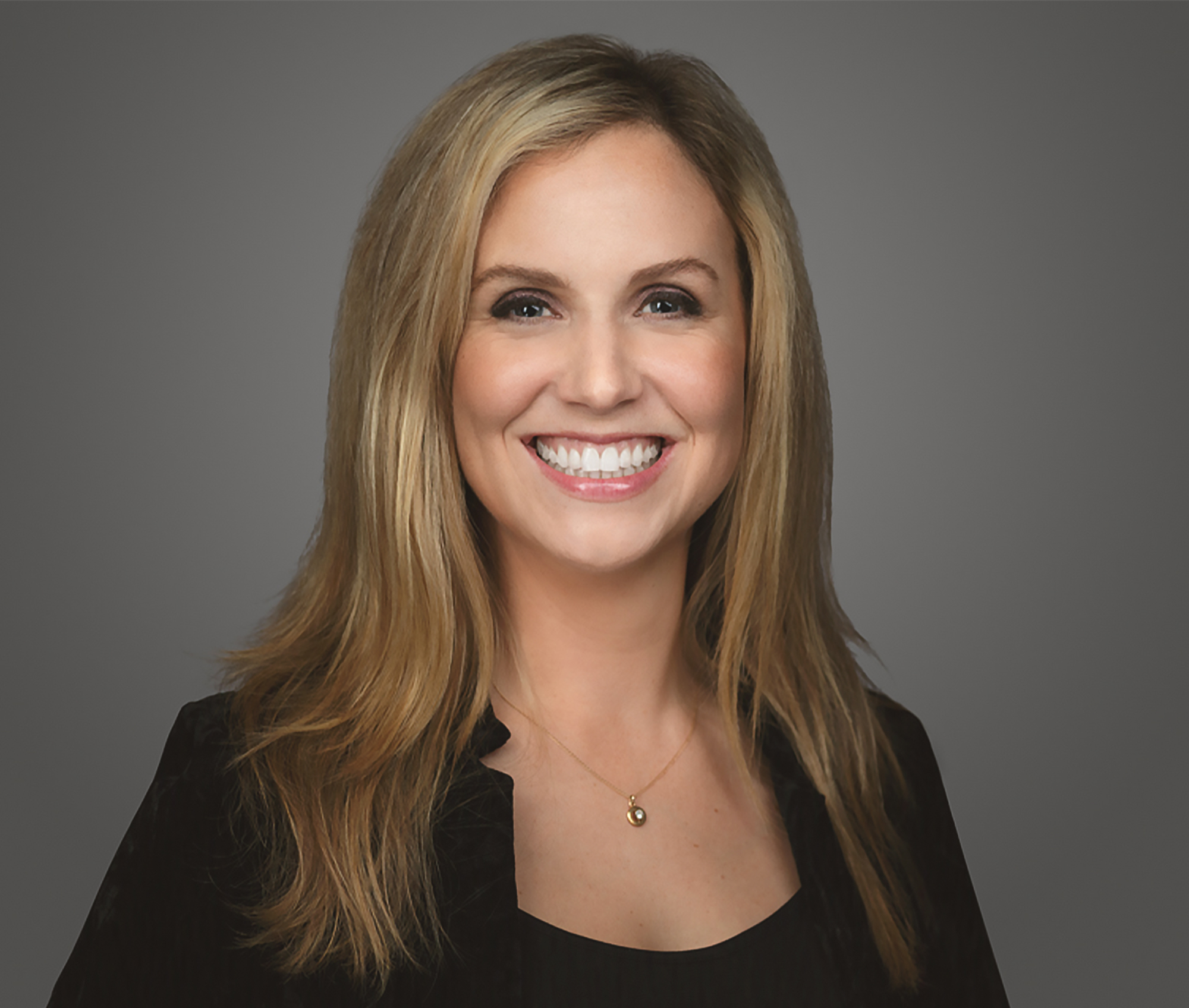Not just another fund shop, the Advisor 123 team leverages Altruist for their own client-facing RIA, giving them a unique perspective on what it takes to grow your practice. They are in the trenches alongside you, delivering practical and intentional guidance as a true partner.
We recently sat down with the founding team: Head of Investment Strategies Derek Prusa, Head of Business Development Andrew VanDerSchaaf, and Head of Financial Planning Benjamin Webster to discuss their unique ties with Altruist, how their thinking on investment management has evolved over the years, and key considerations when choosing investments.
What led the three of you to start Advisor 123?
We started Advisor123 to fill a gap we saw in the industry. When it came to portfolio management it seemed there were only a couple of options available: outsource it to an expensive third-party asset manager or do it in-house by yourself. There didn’t seem to be many options between, so our goal was to create a platform that helped bridge that gap, offering a cost-effective alternative to the traditional way of asset management.
We really wanted to help other advisors scale their businesses more efficiently by providing flexibility around portfolio design, increased profitability, and a lower total cost for the end client. Altruist had already tackled a lot of this by helping simplify billing, trading, and account opening, so with our background, it made sense to focus more on portfolio management, communication, and coaching.
Derek, this is kind of a homecoming for you in a way. Tell us about your history with Jason and what makes you excited about being on the Altruist platform.
It’s definitely very exciting to get the band back together and work alongside Jason again, along with the Altruist team. Jason and I first met in late 2014, when I was in the process of transitioning jobs. Having recently passed the CFA Level II exam, I was looking for something more focused on portfolio management and analysis.
I received a call from Jason and his team for an interview. Once I got to know Jason and his vision for his company and the industry, I immediately knew I wanted to be a part of it.
Being somewhat of a startup, Jason wore many hats. As I continued along the CFA path, Jason and I worked hand in hand in designing, implementing, and managing portfolios. Over time, Jason continued to shift his focus on the path that eventually led to him starting Altruist, so I continued to take more off his plate along the way until I was largely responsible for managing the portfolios - close to $4 billion of assets at the time.
Looking back, Jason provided a TON of invaluable guidance along the way. He allowed me to learn by doing, while also helping me understand how various concepts worked in real-world applications rather than just relying on my book smarts. I’m not sure there are many other situations where I would have had as much opportunity to grow my skill set at such an early point in my career.
Fast forward to today, we’re excited for our paths to come full circle. Jason and his team have built a fantastic platform to help simplify running an RIA, and our team has worked hard to create a model lineup to help advisors create bespoke portfolios for their clients, so the two platforms seem to fit really well together - something we have been able to see firsthand with our own client-facing RIA firm where we also use Altruist. Our RIA is more of a pet project to keep our street cred if you will. However, it does help us be more intentional in providing model delivery and advice to advisors we work with in being more of a true partner versus just another portfolio manager. Essentially ‘walking the walk’ to ‘talk the talk.’
Can you tell us about your strategies and how your thinking on investment management has evolved over the years?
At a high level, we take a rules-based, emotion-free approach to investment management. There are numerous studies showing that human behavior is one of the biggest detriments to long-term results, so we wanted to remove that hurdle from the decision-making process.
Through all of our collective experience and research, we've found that all too often managers lean toward complexity. For example, making frequent all-or-nothing shifts, with layers and layers of data to make that decision. Their pursuit is to find the perfect model that works all of the time (spoiler alert, that doesn’t exist).
With that in mind, we set out to build a holistic model lineup, with strategies ranging from passive to more tactical. Advisors then have the ability to piece together the investment styles that fit their specific preferences and client needs, rather than trying to force everybody into the same box.
This also helps from a real-world application when implementing the models in client portfolios. For example, a Roth IRA should typically be managed differently than a Traditional IRA, as there are different time horizons and tax considerations for the different account types. Having a lineup to choose from rather than just one attempted catch-all strategy provides more flexibility to enhance the effectiveness of asset location - not only looking at it from an investment management perspective but also considering the real-world application of how it flows through to the end client.
In your opinion, what should advisors keep in mind when choosing investments?
There's a ton to unpack with this, but a few key considerations come to mind:
- Asset location is huge. Allocating a client appropriately from a risk perspective is important, but we can be much more efficient. Playing off the thought from earlier, if a client has a Roth IRA and a Traditional IRA, it generally makes sense to take more risk in the Roth and less risk in the Traditional. This can help grow the tax-free dollars more aggressively and minimize potential RMD burdens, providing a potentially huge tax benefit to the client over their lifetime. Account types should be considered when choosing the right investments there within.
- Keeping costs low is important. At the end of the day, higher expense ratios eat into the total return that the client receives. Vanguard has published a study that shows advisors can help save their clients on average 34 bps annually by simply using low-cost holdings. This is why we use low-cost indexed ETFs or individual stocks for most of our model holdings. This creates a win-win for clients and advisors as there is less drag on performance for clients, which results in a higher AUM level for the advisor. Also, it helps bulletproof the portfolio if a client were to seek out a second opinion (whether we like to admit it - it will happen). It’s much more difficult to criticize a client holding a low-expense Vanguard ETF than it is to poke holes in an active mutual fund, often with significantly higher costs.
- Don’t dismiss the value of portfolio transparency. We intentionally use low-cost household ETF names as it provides familiarity and allows the clients to see the direct underlying movements instead of trades being buried within a fund. For example, if a model shifts from overweight growth to overweight value, it’s more powerful to see that happening at the account level rather than seeing a single ticker and likely not even realizing the adjustments being made. Clients will better understand what they own, how they are positioned, and any adjustments their advisor might be making based on market conditions.
- Minimize the impact of emotions and behavioral biases. With so much information available these days, it's easy to get caught up in the costly fear/greed cycle. Dalbar releases a robust annual report that details how human emotion, and therefore investment behavior, negatively impacts investment returns. Oftentimes, people are their own worst enemies when it comes to making rational investment decisions. Beyond providing behavioral coaching for clients, it’s important to put clients in the right models in the first place. For example, if a client likes the story of a more tactical investment approach, but can’t stomach periods of underperformance relative to the markets, there needs to be some reconciliation. Either more education for the client on what to expect, looking at another investment style that better aligns with their biases or meeting in the middle by blending some tactical with another investment style to offset some of the market discorrelation.
Lastly, we believe it's important to provide clients with a portfolio that’s tailored to their individual needs and goals. That being said, this doesn’t mean we should create a different blend for every single client that we work with. In our experience, we have found the core of most advisors’ client base have more similarities than not. This provides the opportunity to create a series of core portfolio lineups that can be used to achieve those common goals, increasing scalability. Having a repeatable message around investment decisions and performance allows you to allocate your time where it is best spent - helping clients realize their goals.
How do you keep your costs so low and what makes Advisor123 different from other model providers?
For starters, adhering to an emotion-free, algorithmic investment process, allows us to run relatively lean as a company. We don’t need an entire department of analysts digging into each holding and providing their opinions. The formulas make the decisions.
While we do make adjustments within the models that we manage, we avoid expensive mutual funds. We are big believers in using low-cost ETFs whenever possible and have a couple of individual stock models to further reduce the holding costs. As we mentioned earlier, any fees we can trim for the end client are only going to put them in a better position in the long run.
With this type of approach, we also feel it better highlights the value the advisor brings in their investment advice. You can tell the story and educate clients about your management process, and they can see it more directly unfold within their accounts - all through funds that are your household names. We believe the added visibility and transparency help build credibility and trust.
Lastly, we see ourselves working more closely together as a partner with advisors. Leveraging Altruist to run our own client-facing independent RIA, we have a unique perspective that helps us deliver more practical advice and guidance to the advisors we work alongside.
Can you talk a bit about your team’s portfolio construction process and philosophy?
Absolutely! Our goal was to build a lineup of various individual models, each with a different purpose in mind to help advisors create more holistic portfolio blends. We use an emotion-free, rules-based approach to managing our investment models.
When creating a model, we first define the broad goals and general parameters of what the model is intended to do. Then, we research more specific information on how to best start constructing the model to achieve its desired goals. Through this process, we run numerous iterations and stress-test the model, generating multiple potential versions of the model. After we have a handful of viable model scenarios, we review the data from each, returning to the iteration phase with the strongest contenders. Once we feel confident that we have a finalized product that meets the intended goals in an efficient manner, we approve the model.
Can you tell us a bit more about the Advisor123 strategies that are being added to the Altruist Model Marketplace?
We understand there isn’t a one size fits all model that’s perfect for every client. This is why we created a wide lineup with varying investment strategies and styles. Advisors can either use a stand-alone model for a specific client need or blend some models together for a more holistic portfolio. These range from passive to more tactical in nature.
- Dynamic Growth: An actively managed ETF model with the ability to overweight or underweight various segments of broad markets.
- Dynamic Growth PLUS: Managed exactly like Dynamic Growth except it has the ability to hedge risk in an attempt to mitigate abrupt market declines.
- Dynamic Income: An actively managed ETF model with the ability to overweight or underweight various segments of broad fixed-income markets.
- Tactical Growth: An actively managed ETF model with the ability to overweight or underweight various segments of broad markets, as well as make shifts in its risk tolerance level.
- Tactical Growth PLUS: Managed exactly like Tactical Growth except it also has the ability to hedge risk in two separate manners (by measuring the overall health of markets and the economy on a longer-term basis and by measuring technical market trends on a more intermediate basis for abrupt market declines).
- Tactical Income: An actively managed ETF model with the ability to overweight or underweight various segments of broad fixed-income markets. Even in normal market conditions, the model deliberately excludes holdings that don’t appear favorable based on market trends.
Strategic Growth - A broadly diversified growth-oriented asset allocation model. The model utilizes ETFs to gain exposure to various equities and real estate. - Strategic Income: A broadly diversified fixed-income ETF asset allocation model. The model offers exposure to various fixed-income asset classes.
- ESG Growth: A broadly diversified growth-oriented asset allocation model focusing on ethical investing. The model utilizes ETFs to gain exposure to various equities. With an emphasis on environmental, social, and governance factors, the model holds a slight tilt toward clean energy as well as employee and community treatment.
- ESG Income: A broadly diversified fixed-income asset allocation model focusing on ethical investing. The model offers exposure to various fixed-income asset classes. While the turnover in this model is relatively low, the longer-term focused holdings were strategically selected to provide stability during periods of economic and stock market uncertainty and volatility.
- Dividend Focus: An actively managed individual US stock model. The model focuses on companies in the S&P 500 with dividend yields higher than the median of the Index.
- Growth Focus: An actively managed individual US stock model. The model focuses on companies in the S&P 1500 (a blend of large, mid, and small-cap) with above-average sales and earnings growth.
- Sector Rotation: An actively managed ETF model with the ability to overweight or underweight the various sectors of the US stock market.
- All Weather: An actively managed ETF model with the goal of providing growth and stability regardless of market conditions. The model utilizes various asset classes that have historically worked in different types of economic regimes.
- Dynamic Short: Term Income An actively managed ETF model with the ability to overweight or underweight various segments of broad fixed income markets, with a tilt to shorter-duration holdings.
- Income Focus: An actively managed ETF model designed to produce consistent income and dividend payments. To achieve this goal, the model has the ability to overweight or underweight its core holdings within various market segments.
The Advisor123 series is a suite of model portfolios made available on the Altruist Model Marketplace. Altruist LLC and its affiliates (together, “Altruist”) do not render investment advice to retail clients, rather Altruist makes available certain model portfolios for independent RIAs’ use in managing their retail investment clients’ assets. RIAs are responsible for suitability of all transactions in and decisions regarding client accounts, and must maintain discretion over client accounts which are subscribed to Model Marketplace model portfolios.
For more on the Advisor123 series review the series fact sheets available within the Model Marketplace. For more information on Altruist’s Model Marketplace please see the Form ADV Part 2A, Model Marketplace Agreement and Altruist LLC Fee Schedule on altruist.com/legal.













